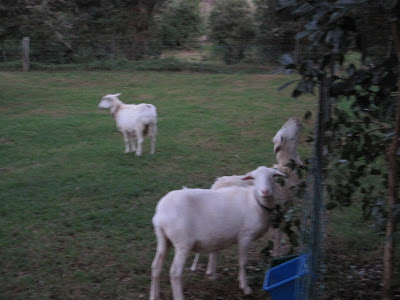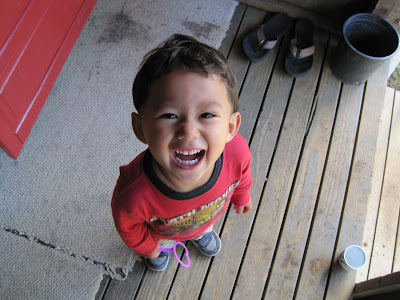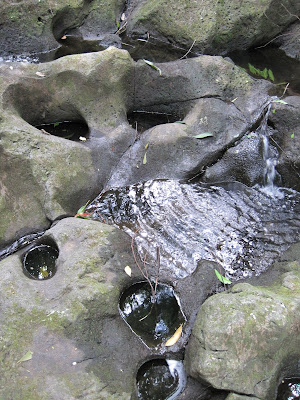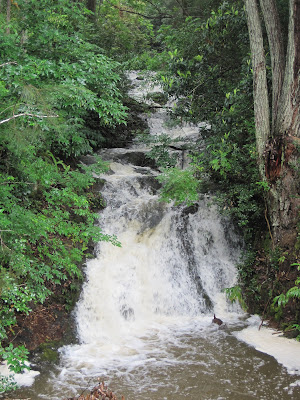Hi everyone,
Sorry we haven't posted in a while, it's so hard to get computer time at the Honoka'a library.
Oh how time flies! After almost 3 months at Mauna Kea Tea Garden, we are getting ready to pack up and move on to another farm in Kapoho, a fruit farm this time. It's hard to believe that we'll be leaving this wonderful place in just 10 days. Taka and Kimberly really made us feel like part of the family. It's been great working on a farm that is only five years old; we got to see every part of the process, from clearing land for fields to harvesting from mature tea plants. So much of a farmer's work is long-term, doing things that will pay off a year or five years in the future, so it's very rewarding to see our work make a difference in just a couple of months.
We have learned and experienced so much at MKTG that it naturally feels sad to move on, but we're also excited about continuing our adventure, doing new things and meeting new people. Our next farm is in Puna, also on the rainy side of the island but not at such a high altitude. We have heard much about Puna and are looking forward to experiencing it firsthand. People say it is a younger, more artistic community with lots of markets and music. Sounds like a wonderful place to be for the summer months! It also is closer to the beach than we are in Hamakua, another plus.
We will be adding more pictures and doing more things before we leave though, so stay posted.
Monday, March 29, 2010
Thursday, March 18, 2010
An existentialist can of worms
Today was a dreary day on the farm... we woke up to the relentless percussion of torrential rain and soon discovered it was too wet to do any field work. We went up to the farmhouse to collect two more chickens for us to feed and care for in exchange for eggs. We clipped their wings (a painless operation) and put them in with our other hens. They immediately started fighting and scratching for the top spot in the pecking order. They didn't stop bickering until I dug up a bunch of worms from the garden and threw them into the fray. I guess it will take them a while to get used to being cooped up together.
But this brings me to the cause of my dilemma. Shortly after our chickens started giving eggs, we noticed that rats and mongeese (or mongooses) were raiding the coop at night and stealing the hens' food and eggs and generally terrorizing them. We hatched a plan to catch these pests by baiting traps with cheese and peanut butter. Yesterday morning we caught a rat in the snap trap. We found it already dead, and we put its body in the larger cage trap, knowing that mongeese are scavengers attracted to the smell of dead animals. This morning we found our egg thief in the trap, scared and very angry. We knew we couldn't let it free again, so one of us interns took it down to the flooded gulch stream and drowned it.
Worms, rats, mongooses, even intraspecies violence, so much suffering in the name of a few nutritious eggs. It has me thinking about the collateral damage caused by our appetites. How much harm is done just do satisfy our desires? Where should we draw the line? Why is it more repulsive to me to kill a mongoose than a rat, and why do I feel more guilt about killing a rat than about tossing a dozen worms to their deaths? Even living on a natural farm, as conscientiously as possible, we cannot help but disrupt our surroundings and make them unnatural.
Some would say that it is "natural" to own domesticated animals and to protect them from other animals with fences and traps and weapons, that causing such suffering is an extension of the violence endemic in nature, where animals kill each other all the time. This kind of rationalizing is a thinly veiled way of shirking responsibility for the hubris and destruction perpetrated in the name of our current way of life. I have already mentioned a number of creatures that would be alive today if not for our taste for chicken eggs. Even our hens have been genetically selected to produce unnatural amounts of meat and eggs, to the detriment of their longevity (why bother to breed a healthy chicken when you plan to eat it when it's 2 months old?). The fact is that we bred these chickens to be totally helpless without human care, placed them in the middle of a forest full of hungry animals, and then feel it is our right and duty to kill those animals for trying to take what is "ours". This is only a microcosm of the many ways in which we take what we want from nature at great expense.
The amount of animate and inanimate resources wasted by human societies is unsustainable and untenable. But how can we mitigate the imprudent and improvident effects of our lifestyles? Is the answer to revert to a prehistoric standard, to erase the benefits as well as the shortcomings of modern technology? Of course not. So how can we live in better harmony with nature without de-evolving into cave people or devolving the responsibility to our children and their children? Perhaps we can come close to equitable equipoise with better accounting of the true cost of our actions and appetites, from giant icecaps to tiny tropical worms.

But this brings me to the cause of my dilemma. Shortly after our chickens started giving eggs, we noticed that rats and mongeese (or mongooses) were raiding the coop at night and stealing the hens' food and eggs and generally terrorizing them. We hatched a plan to catch these pests by baiting traps with cheese and peanut butter. Yesterday morning we caught a rat in the snap trap. We found it already dead, and we put its body in the larger cage trap, knowing that mongeese are scavengers attracted to the smell of dead animals. This morning we found our egg thief in the trap, scared and very angry. We knew we couldn't let it free again, so one of us interns took it down to the flooded gulch stream and drowned it.
Worms, rats, mongooses, even intraspecies violence, so much suffering in the name of a few nutritious eggs. It has me thinking about the collateral damage caused by our appetites. How much harm is done just do satisfy our desires? Where should we draw the line? Why is it more repulsive to me to kill a mongoose than a rat, and why do I feel more guilt about killing a rat than about tossing a dozen worms to their deaths? Even living on a natural farm, as conscientiously as possible, we cannot help but disrupt our surroundings and make them unnatural.
Some would say that it is "natural" to own domesticated animals and to protect them from other animals with fences and traps and weapons, that causing such suffering is an extension of the violence endemic in nature, where animals kill each other all the time. This kind of rationalizing is a thinly veiled way of shirking responsibility for the hubris and destruction perpetrated in the name of our current way of life. I have already mentioned a number of creatures that would be alive today if not for our taste for chicken eggs. Even our hens have been genetically selected to produce unnatural amounts of meat and eggs, to the detriment of their longevity (why bother to breed a healthy chicken when you plan to eat it when it's 2 months old?). The fact is that we bred these chickens to be totally helpless without human care, placed them in the middle of a forest full of hungry animals, and then feel it is our right and duty to kill those animals for trying to take what is "ours". This is only a microcosm of the many ways in which we take what we want from nature at great expense.
The amount of animate and inanimate resources wasted by human societies is unsustainable and untenable. But how can we mitigate the imprudent and improvident effects of our lifestyles? Is the answer to revert to a prehistoric standard, to erase the benefits as well as the shortcomings of modern technology? Of course not. So how can we live in better harmony with nature without de-evolving into cave people or devolving the responsibility to our children and their children? Perhaps we can come close to equitable equipoise with better accounting of the true cost of our actions and appetites, from giant icecaps to tiny tropical worms.

Friday, March 12, 2010
Rain, rain, go away...
Thursday, March 11, 2010
The fauna of Mauna Kea Tea Garden
Hi again everyone,
Last time we posted the Big Island was on tsunami alert. It turned out to be pretty anticlimactic. We went to the beach the very next day and had a great time. The tourists mostly stayed away, and the humpbacks were breaching really close to shore, giving us few sunbathers a great show. That night began eight straight days of rain that flooded the farm and made it impossible to do field work. We spent most of last week trying to dig drainage ditches (which didn't work) and sorting and bagging the tea we harvested recently.
But now we've had three days of beautiful weather, and with the sunshine came some new farm residents. We now have two goats living with us, and their arrival made me realize that while I've introduced you to our tea plants and some other local flora, I haven't mentioned the animal side of our work. Here is the cast of characters:

Here are our two chickens. They're an important part of our daily routine on the farm and provide a valuable service by converting our leftover kitchen scraps into delicious eggs! When we supplement their diet with worms (for protein) they are very appreciative.

Being a modern and productive farm, we have three working lawnmowers. They are state-of-the-art, self-powering, biofueled models, and they never break down. They don't work as fast as some other mowers, but they are very thorough.

Meet the newest members of the MKTG family, Noah and Blossom. Noah is 3 months old and Blossom is almost 1 year old. When she gets a little older she'll provide fresh milk for the farm. We spent most of this week building a new pasture for them to frolic and eat to their heart's content. They were raised on a sort of goat version of "attachment parenting" so they cried and cried when we first got them, but they seem happy and are adjusting well.

Here you can see the rare and elusive Koji bear, once thought to be extinct in this part of the world, but we have one in captivity! Due to deforestation and the introduction of invasive species to the island, his natural diet of orange juice popsicles was severely depleted. We're happy to say he's making a full recovery and we hope to release him into the wild as soon as his mom says it's OK.
Last time we posted the Big Island was on tsunami alert. It turned out to be pretty anticlimactic. We went to the beach the very next day and had a great time. The tourists mostly stayed away, and the humpbacks were breaching really close to shore, giving us few sunbathers a great show. That night began eight straight days of rain that flooded the farm and made it impossible to do field work. We spent most of last week trying to dig drainage ditches (which didn't work) and sorting and bagging the tea we harvested recently.
But now we've had three days of beautiful weather, and with the sunshine came some new farm residents. We now have two goats living with us, and their arrival made me realize that while I've introduced you to our tea plants and some other local flora, I haven't mentioned the animal side of our work. Here is the cast of characters:

Here are our two chickens. They're an important part of our daily routine on the farm and provide a valuable service by converting our leftover kitchen scraps into delicious eggs! When we supplement their diet with worms (for protein) they are very appreciative.

Being a modern and productive farm, we have three working lawnmowers. They are state-of-the-art, self-powering, biofueled models, and they never break down. They don't work as fast as some other mowers, but they are very thorough.

Meet the newest members of the MKTG family, Noah and Blossom. Noah is 3 months old and Blossom is almost 1 year old. When she gets a little older she'll provide fresh milk for the farm. We spent most of this week building a new pasture for them to frolic and eat to their heart's content. They were raised on a sort of goat version of "attachment parenting" so they cried and cried when we first got them, but they seem happy and are adjusting well.

Here you can see the rare and elusive Koji bear, once thought to be extinct in this part of the world, but we have one in captivity! Due to deforestation and the introduction of invasive species to the island, his natural diet of orange juice popsicles was severely depleted. We're happy to say he's making a full recovery and we hope to release him into the wild as soon as his mom says it's OK.
Subscribe to:
Posts (Atom)







